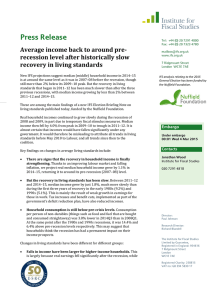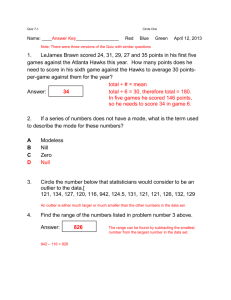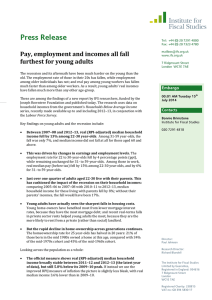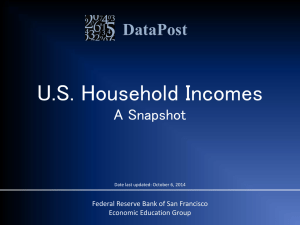Living standards during the recession IFS Briefing Note 117 James Browne
advertisement
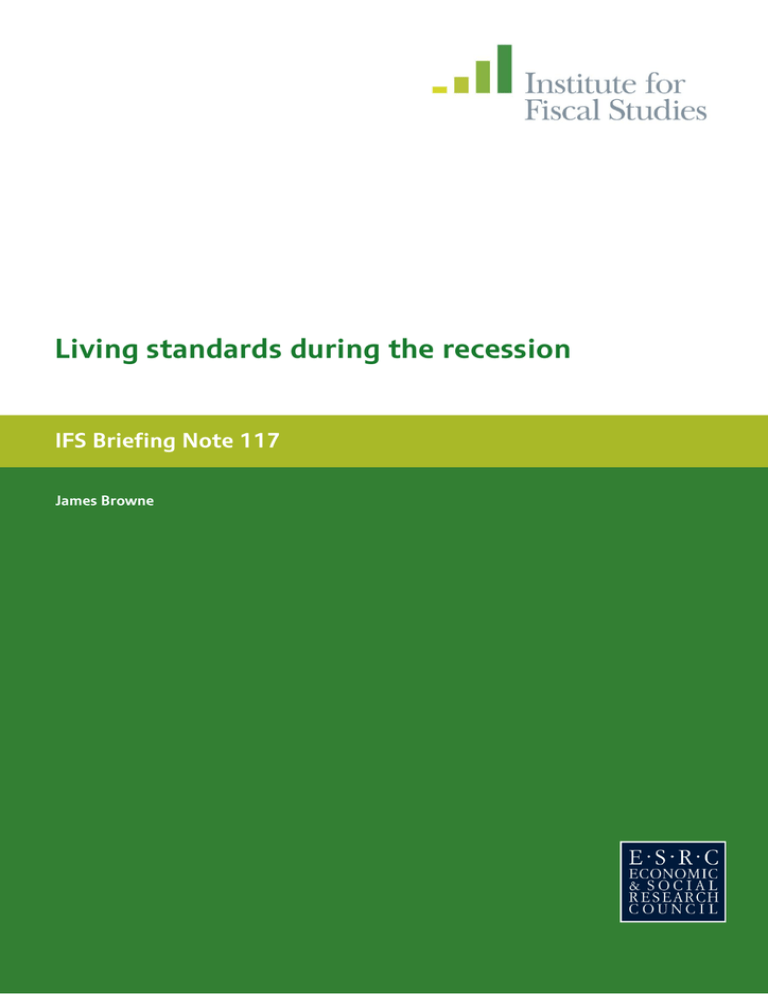
Living standards during the recession IFS Briefing Note 117 James Browne Living standards during the recession James Browne Institute for Fiscal Studies1 1. Introduction We are used to our incomes rising over time. Since 1961, median (middle) household income before housing costs in the UK has increased by 1.6% per year on average. So over a typical three year period real incomes would rise by about 5%. However, our best estimate is that in the three years from 2008 to 2011 real household incomes will in fact have fallen by 1.6% - the biggest three year drop in real living standards since 1980-83. So households are about 6% worse off than they might have expected had incomes risen in the normal way. Our estimates are just that – estimates. We do not yet have real data on incomes in 2011. In this note we have simulated the effects of employment, earnings, interest rate and tax and benefit changes from 2008 to April 2011, including the effects of tax and benefit changes due in April. We look at the impacts on different types of family and at different points in the income distribution. We have not looked beyond April 2011, but note the warnings of the Governor of the Bank of England that real incomes may stagnate for a considerable time beyond that as earnings grow slowly if at all, the outlook for employment is uncertain and further tax rises and benefit cuts are due. Our best estimate is that incomes in 2013-14 will still be below those in 2008-09 and this will be the biggest drop over a five year period since the five years from 1972 to 1977. 2. Methodology In this briefing note, we measure household incomes using the before housing costs (BHC) measure used by the government in its annual Households Below Average Income (HBAI) publication, adjusting for 1 This paper was funded by the BBC and the ESRC Centre for the Microeconomic Analysis of Public Policy at the Institute for Fiscal Studies (RES-544-28-5001). The author would like to thank Mike Brewer, Robert Joyce and Paul Johnson for useful comments on an earlier draft of this Briefing Note. All remaining errors are the responsibility of the author. The Family Resources Survey was made available by the Department for Work and Pensions, which bears no responsibility for the interpretation of the data in this Briefing Note. Contact: james_browne@ifs.org.uk. 1 © Institute for Fiscal Studies, 2009 household size using the OECD equivalence scale. The latest year of data available in this series is 2008–09, which corresponds to the beginning of the recent recession in the UK. Our first step is to use this data from 2008–09 to estimate what median income would have been in 2011–12 if real earnings, interest rates, employment levels had remained at their 2008–09 levels and the April 2008 tax and benefit system had remained in place. Our methodology broadly follows that of Brewer and Joyce (2010) for simulating incomes in future years based on 2008–09 data.2 We uprate this data to 2011–12 prices (increasing all income sources in line with RPI inflation, households’ capital stocks in line with nominal GDP and leaving the interest rate received on savings at its 2008–09 level) and reweight the data to take account of demographic changes (but not changes in the number of individuals employed) in the population between 2008–09 and 2011–12.3 We use the IFS tax and benefit microsimulation model, TAXBEN, to calculate net incomes for households under an unreformed April 2008 tax and benefit system (where ‘unreformed’ means that it is uprated in line with the baseline used by the Treasury in Budgets and Pre-Budget Reports, this generally means that most tax thresholds and benefit rates are increased in line with inflation). Adjustments are then made to take account of the fact that not all households take up the means tested benefits to which they are entitled and that not all households report all their benefit income to the Family Resources Survey on which the HBAI report is based. Having created a 2011–12 population with 2008–09 levels of employment, earnings, interest from savings and with the April 2008 tax and benefit system still in place, we then change each of these in turn to examine the effects of each on median incomes for different household types, and other percentile points of the income distribution. Reducing the number of employed individuals We reduce the number of individuals in work in our simulated population from 29.4 million in 2008–09 to 29.1 million, the Office for Budget 2 See section 2 of M. Brewer and R. Joyce(2010), ‘Child and Working-Age Poverty from 2010 to 2013’, IFS Briefing Note 115, http://www.ifs.org.uk/bns/bn115 for more details. 3 This effectively assumes that demographic changes between 2008–09 and 2011–12 did not come about as a result of the recession or tax and benefit changes; given that the variables we control for are the number of households in each region, the age structure of the population by gender, the number of single-person households, the number of lone parent and couple parent families and the ethnic makeup of the population, we do not believe that this is an unreasonable assumption. 2 © Institute for Fiscal Studies, 2009 Responsibility’s forecast for 2011–12, to get an estimate of the effect of higher unemployment on median incomes for different household types and different percentile points across the income distribution. To reduce the level of employment, we reweight the 2008–09 data to increase the weight given to those households in our data with fewer workers, and decrease the weight given to those with more workers. We force the reweighting procedure to keep other demographic characteristics of the population (age, region etc.) constant while doing this. Reducing the interest rate received on savings Figures from the Bank of England show that the average interest rate received on savings in time deposit accounts in 2008–09 was around 4.4%. Using the latest figures for this series and forecasting it in 2011–12 in line with market expectations of the Bank of England’s base rate as given in February’s inflation report,4 gives us an estimate for the average interest rate in 2011–12 of around 3.5%. We therefore reduce gross income from savings interest by around 20% to take account of this in our simulated 2011–12 population and then use TAXBEN to recalculate tax liabilities and benefit entitlements with this lower savings income to obtain an estimate of the median and other percentile points of the income distribution with the lower interest rate. Reducing real earnings To estimate the impact of the fall in real earnings that has occurred since 2008–09 we increase earned income in our 2008–09 data in line with observed nominal earnings growth to the present time and then forecast growth in average earnings from the OBR to 2011–12 rather than RPI inflation. This reduces earnings in our 2011–12 data by 1.4%. This reduction is uniform across the whole earnings distribution: we do not allow for differential earnings growth by earnings level or between different sectors of the economy. We again recalculate net incomes following the fall in gross incomes using TAXBEN and then recalculate median income and the various percentile points of the income distribution, again correcting to allow for non-take up and non-reporting of means tested benefits in the HBAI data. We do not take account of differential earnings growth at different points in the distribution or between different occupations, in large part because we do not have that data over the whole period. 4 See http://www.bankofengland.co.uk/publications/inflationreport/conditioning_path.htm for the underlying data. 3 © Institute for Fiscal Studies, 2009 Tax and benefit changes To calculate the effect of tax and benefit changes since 2008–09 on different percentile points of the income distribution we use TAXBEN to recalculate net incomes under the actual April 2011 tax and benefit system as opposed to the ‘unreformed’ April 2008 tax and benefit system. As before, we make adjustments to account for non take-up of means-tested benefits and under-reporting in the HBAI data. We do not allow for tax and benefit changes to affect households’ behaviour or for pre-tax prices in the economy to change in response. 3. The impact of the recession on the distribution of household incomes Figure 3.1 shows how we expect the recession to have reduced household incomes at different points of the income distribution. We show how we expect the midpoint of each decile of the income distribution to have changed as a result of the recession and how the midpoint of the overall income distribution is expected to have changed. Figure 3.1: Effect of the recession on various percentiles of the income distribution, 2008–09 to 2011–12 Change in household income before housing costs 1% 0% -1% -2% -3% -4% Tax and benefit changes Real earnings Interest on savings Employment Overall -5% 5th 15th 25th 35th 45th 55th 65th 75th 85th 95th Median Percentile point of the income distribution Note: Incomes are adjusted for family size using the Modified OECD equivalence scale. Source: Author’s calculations using the 2008–09 Family Resources Survey. The factors we analyse here will reduce BHC median income between 2008–09 and 2011–12 by around 1.6%, or £360 a year in 2011–12 prices. Unless other changes offset this fall, this would represent the first time that median income before housing costs had fallen over a three year period since 1990–1993, and it would be the largest fall over a three year period since 1980–1983. The main factors driving this reduction are lower real earnings and lower interest on savings income. 4 © Institute for Fiscal Studies, 2009 Many readers may wonder why we are taking into account the effect of lower interest rates on savings income but not on lower mortgage payments. The reason is that we are using a measure of income before housing costs – using the government’s after housing costs (AHC) measure of household incomes would take this into account, but we do not do so here. However, lower mortgage interest payments do affect our results indirectly through their effect on RPI inflation (mortgage interest payments are included in the basket of goods that are used to calculate RPI inflation). Real earnings would have fallen by more had mortgage interest payments not fallen as inflation would have been higher and therefore the overall fall in median income would have been lower.5 In other words, on average, the fall in mortgage rates are fully reflected in these figures. Tax and benefit reforms between 2008–09 and 2011–12 have acted to increase the median income. Again, some readers may find this surprising. In part this is because, we are only accounting for the direct effect of tax and benefit changes on household incomes – increases in indirect taxes, in particular the increase in VAT that came into effect on 4th January 2011 are not directly accounted for. However, the VAT increase will increase RPI inflation (by around 1.2%), meaning that the fall in real earnings would not have been so great in the absence of increases in indirect taxes. And recall that alongside tax increases like the introduction of the 50p rate and increases in all rates of NI from this April this period also saw increases in the income tax personal allowance and the employee’s NI threshold, benefiting most basic-rate taxpayers and increases in tax credits for families with children. Further tax increases and benefit cuts are due in 2012 and beyond, including reductions in the threshold at which the higher rate of income tax starts to be paid, the withdrawal of child benefit from higher-rate taxpayers from January 2013, a more stringent test for claiming Disability Living Allowance, more aggressive means-testing for the family element of the Child Tax Credit and nominal freezes in the value of the Savings Credit element of Pension Credit and the standard and 30 hour elements of the Working Tax Credit. Looking across the income distribution, it is clear the higher percentiles of the income distribution will see their incomes fall by the most. This is for two main reasons. Firstly, richer households are more reliant on income from earnings6 and savings interest than those lower down the income distribution who receive a greater proportion of their income from the 5 This ignores any macroeconomic or other effects of lower interest rates on earnings levels. 6 Note again that we are assuming that real earnings fell uniformly across the income distribution. To the extent to which this was not the case in reality, this will alter this distributional picture. 5 © Institute for Fiscal Studies, 2009 state. Second, whereas tax and benefit changes over this period have increased the incomes of those at the bottom of the income distribution, the tax rises that were introduced in April 2010 hit the very rich, and the increase in the National Insurance rates mean that tax and benefit reforms over the whole period act to lower the 95th percentile of the income distribution. In figure 3.2, we examine how the median income has changed for different types of household. We divide households between whether they are of working age or have an individual over the state pension age, and if they are of working age, whether they have dependent children. Change in median household income before housing costs Figure 3.2: Effect of the recession on median income for different household types, 2008–09 to 2011–12 Real earnings Employment Overall Interest on savings Tax and benefit changes 1% 0% -1% -2% -3% Working age Pensioner Working age households with households households without children children Household type Overall median Note: Incomes are adjusted for family size using the Modified OECD equivalence scale. Source: Author’s calculations using the 2008–09 Family Resources Survey. As we might expect, pensioner households are particularly reliant on interest from savings for their income and are therefore particularly affected by reductions in the amount of interest received, but are relatively unaffected by changes in both the level of employment and earnings from employment. Given that the percentage fall in savings income is much larger than the drop in earned income, the reduction in median income among pensioners is greater than for working age households. Pensioners also did not benefit from the tax and benefit giveaways of 2008–09 to 2010–11, which were mainly aimed at families with children, and will not 6 © Institute for Fiscal Studies, 2009 benefit from the increases in income tax and employee’s NI thresholds in 2011–12.7 4. Prospects for household living standards beyond 2011–12 Previous IFS research (Brewer and Joyce, 2010) has suggested that median income will continue to fall in 2012–13 but increase slightly in 2013–14, so that median income in 2013–14 would be approximately the same as in 2011–12. Therefore, median income will be lower in 2013–14 than it was in 2008–09. This would be the first five-year period in which median income before housing costs fell since the five year period from 1990 to 1995, and the largest drop in a five year period since the five years from 1972 to 1977. Key contributors to this are that earnings growth will not keep pace with inflation in 2012, and that more tax rises and benefit cuts will be introduced between 2012–13 and 2014–15 as part of the government’s deficit reduction package. The last of these are likely to have a different impact across the income distribution and family types than the changes we examine in this note. In particular, low income families with children are likely to be the most affected by tax and benefit reforms to be introduced over this period whereas pensioners are relatively unaffected.8 5. Conclusion The recent recession has had a negative impact on living standards in the UK through its impacts on lower employment and earnings levels. Cuts in interest rates have reduced the amount of income received from savings and tax and benefit changes have increased the incomes of some households but reduced those of others. Overall, these factors reduce the median household income before housing costs by 1.6% over the period from 2008–09 to 2011–12 or around £360 a year. Unless other changes offset this fall, this would represent the first time that median income before housing costs had fallen over a three year period since 1990–1993, and it would be the largest fall over a three year period since 1980–1983. However, this fall in the median income only shows what will happen to the middle of the income distribution – other parts of the distribution will 7 Note again that we do not take into account of lower mortgage repayments except in their effect on the overall inflation rate – were we to take account of differential inflation rates between households, we might find that inflation rates for pensioners were particularly high given that very few pensioner households have mortgages and mortgage interest payments have fallen over this period. 8 For more on the distributional implications of tax and benefit changes, see J. Browne (2010), ‘Distributional analysis of tax and benefit changes’, presentation given at IFS post-Spending Review briefing, http://www.ifs.org.uk/publications/5313. 7 © Institute for Fiscal Studies, 2009 be affected differently by these changes. In particular, richer households who are more reliant on income from savings interest and earnings are more affected than those lower down the income distribution who receive more of their income from the state. Similarly, pensioners are the household type that has been worst affected mainly as a result of the reduction in the interest rate they receive on their savings and because they have not benefited from the previous government’s giveaways to households during the recession. Looking forward beyond 2011–12, it is likely that household incomes will remain stagnant for some time to come. As the Governor of the Bank of England said earlier this year,9 real earnings growth is likely to be subdued for several years because of the weak conditions of the labour market. Further tax rises and cuts to benefits have already been announced by the government to come into effect in 2012–13 or later, which will tend to further reduce household incomes. It is therefore likely that median income in 2013–14 will be below its level in 2008–09. If so, this would be only the third five year period since 1961 in which median household income had fallen in real terms. 9 See http://www.bbc.co.uk/news/business-12282405. 8 © Institute for Fiscal Studies, 2009



